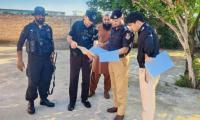The onset of the COVID-19 pandemic in Pakistan prompted the government to implement a country-wide closing of schools and colleges as a measure to protect children and prevent the spread of disease. The decision was taken after much deliberation. On onehand, school closures have been one of the most effective social distancing measures globally, but these come with serious costs. Learning outcomes for our future generations have the potential of being disrupted, especially for the poorest with little access to remote learning and online education. In addition, the livelihood of millions of teachers and faculty was put on risk along with the survival of thousands of low and middle-income private schools which provide an important source of bridging the gap between demand and supply of schools for a large part of the population. With a significant reduction of disease burden in our society, the time has now come for us to consider letting our children, teachers and faculty return to schools, colleges and universities. A safe return to education will require careful planning, community buy-in and joint execution.
The latest scientific evidence suggests that young children in schools are at lower risk for serious consequences COVID-19 compared to adults; susceptibility to infection in people under 20 years of age is approximately half that of adults aged over 20 years. When children do become infected, they are far less likely to suffer severe symptoms of the illness and are 42% less likely to be an infected contact. Children and adolescents under 18 years of age account for less than 7 percent of COVID-19 cases and less than 0.1 percent of COVID-19-related deaths. However, rare instances of severe disease and inflammatory response in young children have been reported.
Pakistan has over 50 million young people in educational institutions, over 300,000 schools and 20 million teachers. The in-person school environment is important because it supports the development of social and emotional skills, creates a safe environment for learning and facilitates physical activity, especially among very young children where alternative strategies such as on-line learning are not an option. These key windows of opportunity do not return and this is why there is so much concern about keeping schools closed for so long, given the potential negative impact at the individual, and societal level. To illustrate, the primary school children that were out of school during the Ebola outbreak in west-Africa are struggling to catch up with their peers even 6 years after the epidemic. Furthermore, protracted closure of the education sector for six months has also hurt education economics with thousands of low-cost schools at risk of bankruptcy. In effect, closure of schools in the presence of existing disparities in access and enrollments runs the risk of further exacerbating inequality; many boys and especially girls who have now had a disruption in schooling for almost 6 months risk never having to resume education.
We have witnessed a drastic reduction of COVID-19 disease burden in Pakistan, from a height of 6,825 positive cases, a positivity ratio of 24% and over 150 deaths a day, to the current status of fewer than 500 cases daily, positivity ratio of below 2% and less than 10 daily deaths on average. The strategy of ‘Smart Lockdowns’ by the government and strong enforcement of containment measures in virus hotspots has resulted in a stable well-controlled situation. Pakistan’s successful journey on COVID-19 containment has now brought us to the stage where a strong case can be made for a well-considered and cautious attempt at reopening of educational institutions on 15th September. Since May this year, 72 other countries have already reopened schools.
Re-opening educational facilities will take place in phases. We will opt for a staged (some age groups to start first and others to follow) and staggered (dividing students into shifts or different days of the week or staggering into different sections so classroom sizes are kept small) re-opening with extreme care and caution and based on the latest science. Ensuring effective infection prevention and control measures have been essential for all countries that have opted to re-open education facilities, and so will be the case for Pakistan.
Key risk and challenges around re-opening include the potential for resurgence in COVID-19 cases as educational facilities offers an intersection of three distinct environments; teachers, staff and students, that create circumstances for virus transmission to and from the school. If disease transmission becomes too high, localized reclosures will need to be implemented.
Even if the risk for children to get infected is low, school-going children should avoid contact with the elderly and people of any age who are at higher risk for severe illness from COVID-19 such as those with chronic illnesses or those who are immunocompromised.
Key pillars of our guidelines to minimize the risk of exposure and transmission in educational institutions include:
· Staged and staggered approach to re-opening.
· Reviewing and taking stock of all educational institutions for infrastructure, staff training and especially access to running water, clean toilets and hand sanitizers.
· Ensuring physical distancing, with 6 feet between desks/seating and open-air classes where feasible.
· Usage of face mask (these can be washable cloth masks that can be reused) and stringent hand hygiene practices for teachers and children over 12 years of age.
· Avoiding crowding in school transport and premises especially in breaks, and suspension of morning school assemblies
· A structured health screening and sentinel random testing regimen will be adopted by each relevant health authority to ensure continued safety, monitoring and dynamic decision making
Our children’s safety and wellbeing is our collective responsibility and cannot be left only to the government and teachers. Parents and caretakers have a crucial role to play in ensuring the success of these measures.
· Parents will need to educate themselves and their children in infection prevention including regular hand washing, and use of face masks as recommended
· Parents must keep their children at home if they are sick, have a sore throat or flu-like symptoms.
· Parents will need to teach adolescents about physical distancing, hand sanitization and use of face masks as much as possible.
· If there are elderly people or vulnerable adults at home, to try to prevent close contact with children
· Parents will need to cooperate with the school administration and staff and comply with school policies around COVID-19 prevention.
We may have controlled the COVID-19 burden in Pakistan through hard work, but the threat of resurgence is serious and we cannot risk complacency. We will need to work together across all sections of society and unite in the effort to ensure that our children resume safe and effective education as soon as possible.
The writers are Federal Minister Education, Professional Training, National Heritage and Culture; Special Assistant to the Prime Minister on National Health Services, Regulations, and Coordination respectively.
Comments came after Trump reprised his complaint that multiple indictments against him were politically motivated
Wins are Labour’s latest in local elections to councils and mayoralties on Thursday
267 raids were conducted against elements involved in Hawala, Hundi and illegal currency exchange
The mountaineer ascended the peak at approximately 8:50am
Fayyaz Watto given additional powers of DG administration
His oath-taking ceremony was scheduled on Sunday which was postponed due to personal reasons







